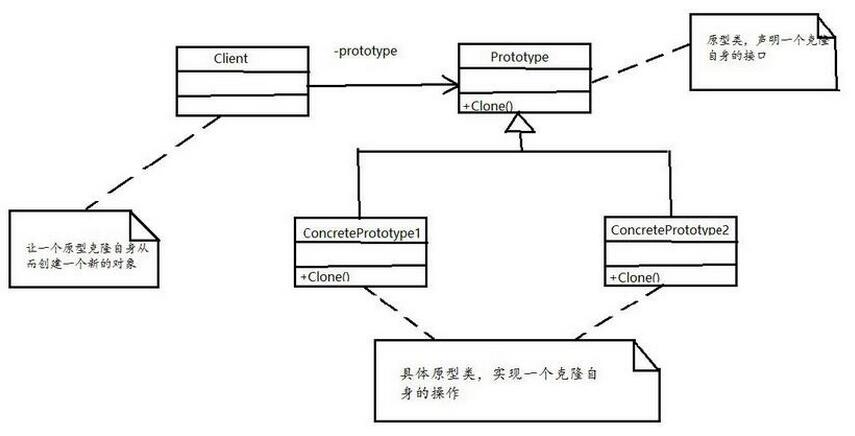Maison >développement back-end >Tutoriel C#.Net >.NET原型模式讲解
.NET原型模式讲解
- 高洛峰original
- 2016-12-10 09:20:291233parcourir
原型模式的定义:
用原型实例指定创建对象的种类,并且通过拷贝这些原型创建新的对象。
原型模式结构图:

创建型模式中一个比较特殊的模式-原型模式,有个最大的特点是克隆一个现有的对象,这个克隆的结果有2种,一种是浅度复制,另一种是深度复制。
创建型模式一般是用来创建一个新的对象,然后我们使用这个对象完成一些对象的操作,我们通过原型模式可以快速的创建一个对象而不需要提供专门的new()操作就可以快速完成对象的创建,这无疑是一种非常有效的方式,快速的创建一个新的对象。
1.原型模式:浅度复制
定义一个接口, 用来表述所有的颜色对象接口
/// <summary>
/// 颜色接口
/// </summary>
public interface IColor
{
IColor Clone();
int Red { get; set; }
int Green { get; set; }
int Blue { get; set; }
}
给出红色的具体实现代码:
public class RedColor:IColor
{
public int Red { get; set; }
public int Green { get; set; }
public int Blue { get; set; }
public IColor Clone()
{
return (IColor)this.MemberwiseClone();
}
}
具体的测试代码如下:
static void Main(string[] args)
{
IColor color = new RedColor();
color.Red = 255;
Console.WriteLine("color -red " + color.Red); //225
IColor color1 = color.Clone();
color1.Red = 224;
Console.WriteLine("color1-red " + color1.Red);//224
Console.WriteLine("color -red " + color.Red); //225
}

可以发现:在我们修改color1对象的Red属性值,没有对color的属性参生影响,即对象副本的修改不会影响对象本身的状态。
2.原型模式:深度复制
深复制考虑的情况相对来说就会比较复杂,因为有可能对象是之间有继承关系或者引用关系的时候,可能我们深复制的时候就需要注意.一般来说深复制一方面可以采用种简单的深复制对象的时候的方案,还可以通过序列化的形式来进行对象的复制。下面通过序列化的形式来实现原型模式:
using System;
using System.Collections.Generic;
using System.Linq;
using System.Text;
namespace ConsoleApplication4
{
/// <summary>
/// 颜色接口
/// </summary>
public interface IColor
{
IColorDemo Clone();
int Red { get; set; }
int Green { get; set; }
int Blue { get; set; }
Factroy f{get;set;}
}
/// <summary>
/// 生产颜色的工厂信息
/// </summary>
[Serializable]
public class Factroy
{
public string name { get; set; }
}
}
using System;
using System.Collections.Generic;
using System.Linq;
using System.Text;
namespace ConsoleApplication4
{
/// <summary>
/// 颜色
/// </summary>
[Serializable]
public class RedColor:IColor
{
public int Red { get; set; }
public int Green { get; set; }
public int Blue { get; set; }
public Factroy f { get; set; }
public IColor Clone()
{
SerializableHelper s = new SerializableHelper();
string target = s.Serializable(this);
return s.Derializable<IColor>(target);
}
}
}
序列化帮助类:
/// <summary>
/// 序列化和反序列化辅助类
/// </summary>
public class SerializableHelper
{
public string Serializable(object target)
{
using (MemoryStream stream = new MemoryStream())
{
new BinaryFormatter().Serialize(stream, target);
return Convert.ToBase64String(stream.ToArray());
}
}
public object Derializable(string target)
{
byte[] targetArray = Convert.FromBase64String(target);
using (MemoryStream stream = new MemoryStream(targetArray))
{
return new BinaryFormatter().Deserialize(stream);
}
}
public T Derializable<T>(string target)
{
return (T)Derializable(target);
}
}
测试:
static void Main(string[] args)
{
IColor color = new RedColor();
color.Red = 255;
color.f = new Factroy() { name="湖北工厂" };
Console.WriteLine("color - Factroy:" + color.f.name); //湖北工厂
IColor color1 = color.Clone();
color1.Red = 234;
color1.f.name = "北京工厂";
Console.WriteLine("color1- Factroy:" + color1.f.name); //北京工厂
Console.WriteLine("color - Factroy:" + color.f.name); //湖北工厂
Console.Read();
}
程序的运行结果如下:

结论:通过序列化和反序列化形成新的对象。其实只要是项目中要使用原型模式进行对象复制的情况下,都可以通过序列化的形式来进行深复制。
Déclaration:
Le contenu de cet article est volontairement contribué par les internautes et les droits d'auteur appartiennent à l'auteur original. Ce site n'assume aucune responsabilité légale correspondante. Si vous trouvez un contenu suspecté de plagiat ou de contrefaçon, veuillez contacter admin@php.cn
Article précédent:.NET工厂方法模式讲解Article suivant:VB.NET生成随机串或随机数字的方法总结

